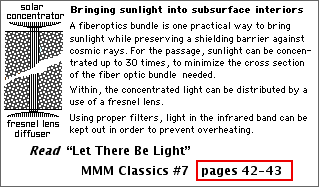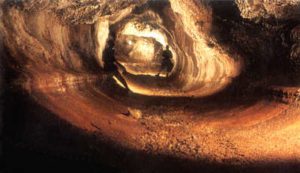As promising as lunar lavatubes are for the future of lunar settlements, in the early days of the frontier, it is more likely that the main settlement complex will be on the surface, covered with a regolith blanket, and that a nearby lavatube will be used for area-hungry unpressurized applications such as warehousing and storage, tank farms, and even industrial parks. Sealing and pressurizing a cave is a daunting task that may not be attempted for some time.
Lavatubes on Earth are much smaller in scale than those on the Moon, probably in some inverse relationship to gravity. Typical widths are on the order of 20-80 ft, but tubes towards the narrower part of that range are more common.
A lavatube in the Azores
Because of their much smaller scale, they are hardly simulation stand-ins for those on the Moon. But we can put them to some use.
In August 1992, I had the wonderful experience of a personal guided tour of the pair of lava tube caves outside Bend, Oregon that the Oregon L5 Society was using for outpost simulation purposes. My guides were Bryce Walden and Cheryl Lynn York of Oregon L5. The photo below shows Cheryl York standing in such an entrance at the Oregon Moonbase site.


Oregon Moonbase Photo taken during a simulation. The PVC tube frame would be covered with a tarp to serve as a makeshift base for students. The cave floor is flat due to the invasion of volcanic ash from the explosive eruption of Mt. Mazama 4,800 BC that formed the jewel known as Crater Lake, 85 miles to the WSW of Bend.

Above: Young’s Cave complex outside Bend, OR.
They put this lavatube complex to work. The mission tested organization, design, logistics, construction, human factors, and educational opportunities. Included were both a surface camp and a ‘lunar base’ inside the cave. The in-tube base consisted of a sleep/work platform, a communications desk, a galley, and a sanitation facility. Mission science included cave mapping, astronomy, geochemistry, and environmental monitoring.
And on July 20, 1989, NASA granted the Oregon chapter $25,000 to do a thorough site characterization.
The Geological survey was done by Stephen L. Gillett, a consulting geologist now in Carson City, Nevada with U-NV-Reno.
Century West Engineering of Bend did the engineering analysis. A series of 5 borings, in roomy locations specified by Oregon L5, showed the roof to be generally from 10 to 20 feet thick with 7-19 ft of hard basalt overlain by 0-3 ft of loose soil. Except for a few transverse cooling cracks, the ceiling is relatively intact and rock quality analysis shows the roof could support from 2-60 tons suspended weight per linear foot, depending on varying roof thickness and the presence presence or absence of fractures. For this, a system of rock bolts will do. In weak areas, roof-shoring supports are advised. Some 6000-7500 cubic yards of sand forms a floor 0-6 ft thick. This could be removed, if desired, by vacuuming. Rock debris could also be removed, if desired, by backhoe or by hoists through openings made in the roof, thereafter available for installation of equipment. But creating such openings whether by blasting, jackhammer, or rocksaw would be a major undertaking. The variations of surface terrain was also surveyed.
The estimated cost of preparing the site as a major lunar analog facility as outlined by the Oregon Moonbase team was over $6 million 1990 dollars. The Phase II grant never came. Eventually, the chapter decided to let the renewable 5-year lease on the facility expire.
But on the basis of what we learned about this pair of lavatubes during the study, we think that this facility, if we could regain access, or a similar tube elsewhere, could support unique simulation exercises. If the main moonbase facility was up on the surface nearby and only limited simulations done in the lavatube “outpost annex”, the cost could be significantly lower, with a very modest initial presence expanded on a pay-as-you-go expansion basis.
The five 60 mm (2 3/8”) bore holes through the tube roof-ceiling, typically through 8-20 feet of overlying soil and basaltic rock, could be used to drop in miniaturized survey equipment designed to demonstrate how we can robotically map the interior of lunar lava tubes in 3 dimensions, profiling their complex shapes and cross-sections.


Someday, lunar lavatubes could be mapped robotically in this fashion, without putting human exo-spelunkers at risk. Those tubes with the most promise for future utilization would then be candidates for further human exploration.
These mapping demonstration tests finished, the bore holes could be filled with fiber optic bundles to let in sunlight pre-concentrated up to thirty times.

Letting the Sunlight in down under
Additional bore holes could be used for communications cable access, electric power supply entrance, fresh water supply, etcetera.
What the Oregon L5 Moonbase Team did, provides a model to follow. A small Habitat complex could be put together out of small inflatable units or of EZ assemble-disassemble semi-prefab structures. At such a facility, where, within the lavatube, lighting would be totally controllable, we could more easily simulate the lunar dayspan/nightspan cycle. We could examine ways of dealing with the two week long nightspan that would let a crew remain productive throughout. We would try to determine how little power we could get by on and still be productive, concentrating on repairs, maintenance, inventory, and other power-light, manpower-intensive tasks, so as to better use the 15 days of dayspan solar power available to store up power to tap after lunar sundown.
Meanwhile, a nearby surface conventional outpost complex would investigate and demonstrate other things: teleoperations; in situ resource utilization; shielding options; and many more lines of investigation. While it would be ideal for the companion analog surface outpost to be very close to the lavatube entrance, a separation of a few miles should not hinder operations. Crew would go from one to the other in a “pressurized vehicle.” This allows room for latitude if it is not possible to have both outpost components closely collocated.
If the access to the Bend, Oregon site can’t be recovered, we might do something similar at lavatube locations at Craters of the Moon National Park, ID; El Mapais National Monument, NM; or Snow Canyon State Park, UT. The advantage of Bend is that the lavatube complex there is well known and studied, and familiar to a number of Moon Society members. At both Bend and at the Mars desert Research Station outside Hanksville, Utah, the landowner is the U.S. Bureau of Land Management through which a free lease can be had under conditions that the site can be returned to its natural state if and when no longer needed. Private land, leased at no cost, is an option as well, but one not so easily arranged.
A Lavatube outpost annex allows the advantage of year-around operation, even in seasonal periods in which the surface outpost may be unbearable or problem-wracked. Underground temperatures stay the same year around.
Further Reading:
What Do Lavatubes Look Like?
http://www.lunar-reclamation.org/papers/lavatube_pix.htm
The Potential of Lunar Lavatubes
http://www.lunar-reclamation.org/papers/lavatubes_ccc.htm
Oregon Moonbase links
http://strabo.moonsociety.org/moonbasesim/moonbase_analogs_net.html#omb
Peter Kokh

